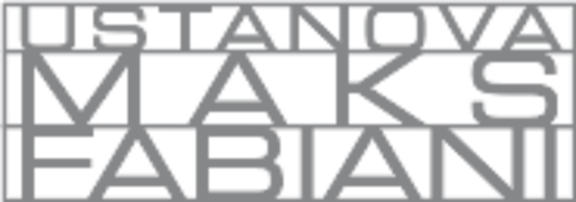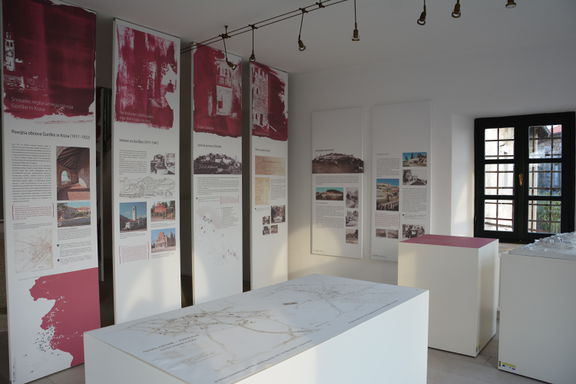Maks Fabiani Foundation
-
6 Mar 2015
Trgovski dom izložba mesta, a permanent exhibition commemorating the 150th anniversary of the birth of Maks Fabiani conceived by Nataša Kolenc and produced in cooperation with the Maks Fabiani Foundation,
Today the archive is housed in the renovated Štanjel castle, which is Fabiani's creation as well. As he was a renaissance type of a man, being also a town planner, an arts historian, a speculative engineer and a painter, philosopher, poet and fiction writer, this archive holds a rather varied collection.
Background
The idea for the foundation was formed while the architect and art historian Marko Pozzetto (1925–2006) was writing his book Maks Fabiani - Vizije prostora [Max Fabiani - Visions of Space], which was published in 1997. Pozzetto has been working on Fabiani for 35 years, during which he has been actively collecting and categorizing relevant documentation and other materials. Upon its founding, he contributed these to the foundation.
This archive became a part of the Centre for Karst Architecture in 2010
Foundation's activities
The foundation's main project, the archive, also functions as library. There, one can find Fabiani's writings, his engineering plans and sketches, second hand assessments of his work and also various studies and photographic representations of his heritage. An extensive catalogue of all this is available on-line.
Other activities involve cooperating in exhibitions and projects like the 2006 documentary on Fabiani and Jože Plečnik. They set up workshops that often deal with practical architectural and urbanistic questions; one can here mention their collaboration with the Department of Architecture at the University of Ferrara. The foundation was also intensively involved in the renovation of the Štanjel village (which was in great part re-imagined by Fabiani) and helped set up the so-called Fabiani trail in that same area, where Fabiani lived out his last few decades. The trail consists of several pathways connecting the locations and buildings that are associated with his life.
Though the foundation existed only unofficially at the time of its release, it is in a way also the publisher of Pozzetto's book on Fabiani. Later, it published a translation of Fabiani's philosophical work Akma : duša sveta [Akma: Soul of the World] and produced various other publications. Since 2006, together with Slovene Association of Urban and Space Planners, the foundation is involved in presenting the Maks Fabiani urbanism award for best projects of urban, regional and spatial planning in Slovenia and, since 2015, also in Austria, Italy, Croatia and Hungary.
Maks Fabiani
In 1865, Max Fabiani was born in Kobdilj, a hamlet in the region of Karst and near the town of Štanjel. When 17, he started his studies at the Vienna Polytechnic Institute, where he attained his doctorate on urban planning, being the first person in Vienna to focus it on this topic. Later he worked as a professor of ornamental drawing, interior design and for a short time also of composition at the Vienna University of Technology. He was the founding member of the Austrian Society for Architecture and the president of the Austrian Society of Engineers and Architects.
Fabiani worked with Otto Wagner for a few years and during that time, though Wagner was the only one credited, they co-wrote the much acclaimed book titled Modern Architecture, which shocked the European architectural community of that time and which has seen countless translations and reissues. They also worked together on Wagner's Vienna Electronic City Railway project.
For a time he worked as an urban advisor at the Viennese Interior Ministry and was later Franz Ferdinand's counsellor for architecture and history of art and urbanism (as anecdotes go, he supposedly advised him – obviously unsuccessfully – not to go to Sarajevo).
His own architectural studio in Vienna was operating between 1896 and 1917. He was commissioned for a number of elite projects in the Empire. Some of them are the still iconic Viennese buildings Artaria, Urania and Portois&Fix. He projected the pavilions for 50th anniversary Franc Joseph's reign, the World Expo in Paris in 1900 and the Imperial Kings exhibition in London. His projects also include Franz Ferdinand's mansion at Brioni, the renovation of the Konopište castle, the Casa Bartoli palace in Trieste and the Spas for civil servants in Opatija.
He left Vienna in 1917 and after based most of his project in either Slovenia or Italy, where his works and urbanistic plans can be found in Venice, Rome, Bologna, Trieste and many other cities.
Fabiani's work in Slovenia
Besides Vienna, Ljubljana bears the mark of Fabiani most strongly. In the aftermath of the 1895 earthquake which destroyed much of the city, Fabiani's proposal was actually the first text on urban planning in Slovenian language. Though this plan was not endorsed as such, most of his ideas were implemented and the present day Ljubljana still displays its logic. Some of his important works in Ljubljana are the Krisper's, Hribar's in Bamberg's mansiones, the Mladika building, the Miklošič park and partly also the Prešeren Square. He also built the much famed and later destroyed pavilion for Rihard Jakopič and at that time even helped the Slovenian impressionists to exhibit abroad.
After 1917, when Fabiani returned to live in Kobdil, he also left a significant mark in that region. He also took over the renovation of the demolished Posočje and Furlanija regions and was the chief architect and urban planner for Nova Gorica, where he stationed his studio until his death.
His restoration of medieval village Štanjel is unique in the way he re-imagined the castle as the place for the municipality offices and vaults and also for the school, the medical centre, the cinema hall and the community dance-hall. As such, this was one of the first examples of giving a new, community based functions to old feudal infrastructure and yet retain their heritage looks.
Plečnik and Fabiani
Jože Plečnik and Fabiani were arguably the two most important Slovenian architects and town planners. They also share quite some common history. Fabiani used to act as Plečnik's his professor at Wagner studio, where they worked together. The older and more worldly Fabiani also Plečnik get around in the Viennese society and academia.
Their work most visibly overlapped in Ljubljana, where, for example, Plečnik created some of his most known works (The Marketplace and the Insurance Company building) based on urban plans of Fabiani. The NUK building was supposedly also very strongly influenced by one Fabiani's church , as was the Vegova street after Fabianis arrangement in front of the Vienna technical university.
Fabiani inventor
Fabiani was a classical all-rounder and as an engineer he worked on very curios, if not always realisable projects. These projects include the machine for walking into the mountains (working on either petrol or compressed air), an armoured tricycle, a warship, a special bicycle, a flying machine powered by hands (the prototype was financed by the Italian army) and an idea for the ventilation of the city of Milano, for which he planned to bring fresh air from the mountains by way of huge ducts and lower the summer temperatures for up to 10 degrees.
Despite the ingeniousness of these ideas, they were never finalised in any functional form.
See also
- Centre for Karst Architecture
- Museum of Architecture and Design
- Slovene Association of Urban and Space Planners
- Plečnik Collection
External links
- Maks Fabiani Foundation website (in Slovenian)
- A catalogue of the foundation's archive
- A documentary on Maks Fabiani and Jože Plečnik (in Slovenian)
- An article of Fabiani's engineering projects (in Slovenian)
- Brochure on the CKA and Max Fabiani (PDF) (English, German, Italian)
- The Fabiani Path




